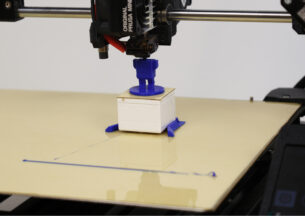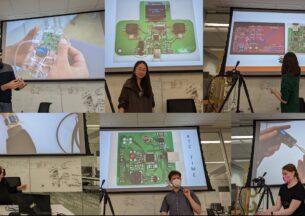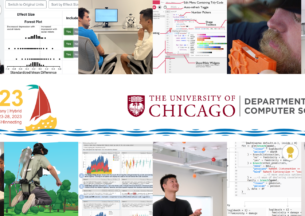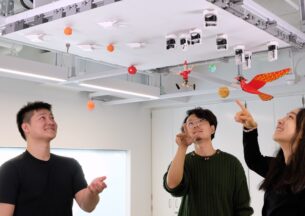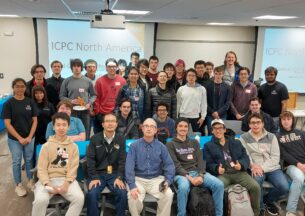New Assistant Professor Sarah Sebo Wants to Build Better Robot Teammates

While the 21st century has realized many of the technological promises of science fiction, robots have yet to fulfill their potential. Beyond specialized models for manufacturing or relatively simple toys, robots remain confined to the laboratory, prototypes that haven’t crossed over to affect most people’s lives. But Sarah Sebo, who joined UChicago CS this fall as an assistant professor, sees a brighter future where robots productively team up with humans in all lines of work, helping humans understand themselves a little better along the way.
Sebo’s research focuses on human-robot interaction, a subset of the human-computer interaction field. While earning her PhD at Yale University, she worked in the Social Robotics lab of Brian Scassellati, using computational modeling and interactive robots to study human behavior and the effectiveness of robotic assistants in school settings and within collaborative teams.
The implications of her work go beyond technology: not just designing more effective robot co-workers or school tutors, but using robots to encourage the humans around them to act in ways that are more inclusive, helpful, and productive. That makes Sebo’s research inherently multidisciplinary, bridging computer science and the social sciences.
“I'm very interested in human behavior and human psychology, and I think it's really interesting to study that using robots,” Sebo said. “With robots, you can control them very specifically, where you can't control a human in the same way. My interest is thinking about how we can understand human behavior by having to program it very specifically in a machine, because if you leave out one ingredient with a robot, then it's not going to work, or it's not going to feel like interacting with a person.”
As an undergraduate at Franklin W. Olin College of Engineering, Sebo’s passion for robotics and computer science was ignited by a class project where she studied the algorithms behind self-driving cars, which she applied to programming a robot to navigate a maze.
“That was the project that really motivated me to apply to graduate school,” Sebo said. “I really enjoyed being able to make a robot intelligent in a similar way to how humans are intelligent, but also in this very different, math-y way, as opposed to how the neurons in our brain work — basically simulating human intelligence by using properties of math and computer science.”
At Yale, she examined how adding a robot to a team of children or adults could affect the dynamics of the group, improving not just overall performance on a task but also the interactions between humans. To do so, she programmed robots to exhibit behaviors more associated with humans — specifically, vulnerability. Instead of the cold, calculating robotic stereotype, Sebo’s robots express doubts about their actions, apologize, tell jokes, and talk about their feelings.
When a team of humans was paired with one of these vulnerable robots, they talked more with each other, spread the conversation around more equally, and reported a more positive experience than teams working with “neutral” robots. The paper was published in the Proceedings of the National Academy of Sciences and was covered in Scientific American.
[Watch a video on Sebo's vulnerable robot from Yale University.]
“My goal is not to have people become BFFs with a robot,” Sebo said. “What I was trying to do in this study was not just have a robot that could do its own task well, but a robot that might benefit the relationships that people might have in the group with one another. I want my robotic technology to bring people together as opposed to drive them apart.”
Sebo and her collaborators have also looked at how humans perceive robots displaying other human-like behaviors, including a robot who cheated at a game of rock-paper-scissors and insulted its opponent. Her thesis also includes work on making robots more sensitive to the social cues of humans, paying attention to factors such as verbal backchannels — short statements such as “yes” and “huh” that signal attention — to “take the temperature” of a group interaction.
At UChicago, Sebo established a Robotics Lab in the John Crerar Library building, where students can tinker with and program several different types of robots. She also started the first robotics courses in UChicago CS, including an Introduction to Robotics class that she will teach in the winter and spring quarters this year. Her research will continue to look at new, longer-term ways robots can assist humans, such as programming them with social behavior to help users better accept robotic assistance on tasks such as remote education or taking prescription drugs on time.
The new facilities at UChicago CS and the rapidly growing human-computer interaction group — which also includes faculty members Marshini Chetty, Pedro Lopes, and Blase Ur — were a major draw for Sebo to join the department.
“There seems to be a very positive energy about the department; a desire to grow, to explore new areas, and for young faculty to have a hand on the steering wheel of where we're going,” Sebo said. “The HCI group was really exciting to me as well, it's really looking to push the boundaries and explore new and exciting directions.”


